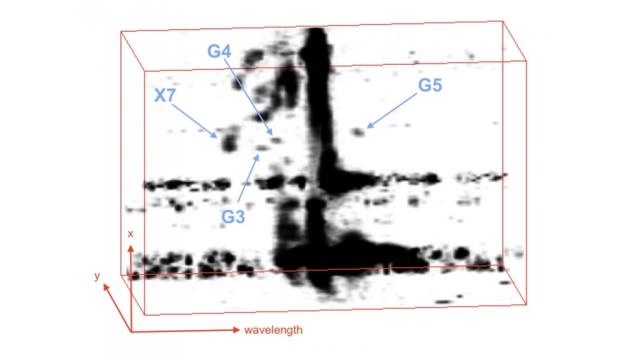The centre of our galaxy is an extreme place that holds all sorts of mysteries. Among those enigmas are what appear to be gas clouds that somehow refuse to be pulled apart by the immense gravity of the galactic centre.
Scientists usnig the Keck Observatory have discovered several more of these infrared-emitting objects, they reported at the American Astronomical Society Meeting in Denver this week. Understanding what these things are will take more work.
“How did they get there? And what will they become? They must have an interesting story to tell,” University of California, Los Angeles postdoc Anna Ciurlo said in a press release.
The story begins, not with the first such object discovered, but the second, G2, spotted in 2012, according to a recent paper. It appeared to be a cloud of gas about three times the mass of the Earth, according to a recent paper.
Data showing each of the infrared-emitting objects. Image: W. M. Keck Observatory
But then it passed close by the behemoth black hole at the Milky Way’s centre, which is four million times the mass of the Sun. The encounter was close by galactic scales – the distance was a bit more than five times the distance from the Sun to Pluto, which is pretty small when you’re dealing with a supermassive black hole.
Scientists expected the black hole (named Sagittarius A*) to tear G2 apart – but the object survived. They later realised that G1, which was discovered back in 2004, but only after it made its closest approach to the black hole, was a similar object.
The researchers from UCLA, Keck and the Instituto de Astrofisica de Andalucia were able to pick out three more of these objects from data taken by the Keck telescope. Those puffs are named G3, G4 and G5.
The researchers think that these objects are stars surrounded by a layer of gas. They would have become puffy thanks to interactions with the black hole, but their centres were massive enough not to fall apart. Perhaps merging stars created the puffs, the scientists speculate.
It isn’t clear whether the three new warm fuzzies are actually the same kind of object as G1 and G2. They will need to face a trial-by-gravity against the black hole, which will occur when they make their closest approach over the next few decades, according to the press release.
The galactic centre is nothing like the region where our own Solar System orbits. And that just makes it all the more interesting for us to study.
[via the W.M. Keck Observatory]
